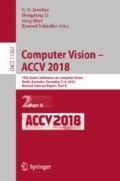Abstract
The Guided Light Field Cost Volume (GLFCV) is a light field disparity estimation algorithm designed for (GPU) parallelization by refactoring the process, such that costly optimizations that combine and refine depth maps are simplified. The algorithm involves shearing the light field over a range of disparities and computing a cost volume for each sheared sub-aperture image. A guided filter is then run on the computed cost for each disparity. For the final disparity estimate, each pixel is assigned disparity associated with the lowest filtered cost. Execution time and accuracy were evalulated on Lytro Illum imagery and also on synthetic light fields from the HCI 4D light field benchmark. The approach presented executes in four seconds (on an NVIDIA Titan XP), with only 10% of pixels in the disparity estimate deviating from ground truth. This compares favourably to existing accurate approaches, whose execution time is in the order of minutes.
Access this chapter
Tax calculation will be finalised at checkout
Purchases are for personal use only
Notes
- 1.
Four dimensional light field data can be parameterised as L(x, y, s, t) [9], which is a pair of planar coordinates where for every fixed pair of (s, t), varying the (x, y) coordinates gives a different pinhole view (or sub-aperture image) of the scene. This parameterisation is used throughout.
- 2.
Available at: http://hci-lightfield.iwr.uni-heidelberg.de.
References
Blender Online Community: Blender - a 3D modelling and rendering package. Blender Foundation, Blender Institute, Amsterdam (2017). http://www.blender.org
Bradski, G.: The OpenCV library. Dr. Dobb’s Journal of Software Tools (2000)
Dansereau, D., Bruton, L.: Gradient-based depth estimation from 4D light fields. In: Proceedings of the 2004 International Symposium on Circuits and Systems, ISCAS 2004, vol. 3, pp. III-549. IEEE (2004)
He, K., Sun, J.: Fast guided filter. CoRR abs/1505.00996 (2015). http://arxiv.org/abs/1505.00996
Honauer, K., Johannsen, O., Kondermann, D., Goldluecke, B.: A dataset and evaluation methodology for depth estimation on 4D light fields. In: Lai, S.-H., Lepetit, V., Nishino, K., Sato, Y. (eds.) ACCV 2016. LNCS, vol. 10113, pp. 19–34. Springer, Cham (2017). https://doi.org/10.1007/978-3-319-54187-7_2
Hosni, A., Bleyer, M., Gelautz, M.: Secrets of adaptive support weight techniques for local stereo matching. Comput. Vis. Image Underst. 117(6), 620–632 (2013). https://doi.org/10.1016/j.cviu.2013.01.007
Jeon, H.G., et al.: Accurate depth map estimation from a lenslet light field camera. In: 2015 IEEE Conference on Computer Vision and Pattern Recognition (CVPR), pp. 1547–1555. IEEE (2015)
Jeon, H.G., et al.: Depth from a light field image with learning-based matching costs. IEEE Trans. Pattern Anal. Mach. Intell. PP(99), 1–14 (2017)
Johannsen, O., et al.: A taxonomy and evaluation of dense light field depth estimation algorithms. In: 2nd Workshop on Light Fields for Computer Vision at CVPR (2017)
Johannsen, O., Sulc, A., Goldluecke, B.: What sparse light field coding reveals about scene structure. In: Proceedings of the IEEE Conference on Computer Vision and Pattern Recognition, pp. 3262–3270 (2016)
Luo, Y., Zhou, W., Fang, J., Liang, L., Zhang, H., Dai, G.: EPI-patch based convolutional neural network for depth estimation on 4D light field. In: Liu, D., Xie, S., Li, Y., Zhao, D., El-Alfy, E.S. (eds.) ICONIP 2017. LNCS, vol. 10636, pp. 642–652. Springer, Cham (2017). https://doi.org/10.1007/978-3-319-70090-8_65
Ma, Z., He, K., Wei, Y., Sun, J., Wu, E.: Constant time weighted median filtering for stereo matching and beyond. In: Proceedings of the IEEE International Conference on Computer Vision, pp. 49–56 (2013)
Neri, A., Carli, M., Battisti, F.: A multi-resolution approach to depth field estimation in dense image arrays. In: 2015 IEEE International Conference on Image Processing (ICIP), pp. 3358–3362, September 2015. https://doi.org/10.1109/ICIP.2015.7351426
Ng, R., Levoy, M., Brédif, M., Duval, G., Horowitz, M., Hanrahan, P.: Light field photography with a hand-held plenoptic camera. Comput. Sci. Techn. Rep. CSTR 2(11), 1–11 (2005)
NVIDIA Corporation: CUDA parallel computing platform (2016). http://www.nvidia.com/object/cuda_home_new.html
Raj, A.S., Lowney, M., Shah, R.: Light-field database creation and depth estimation (2016). https://stanford.edu/class/ee367/Winter2016/Lowney_Shah_Sunder_Raj_Report.pdf, computational Imaging and Display Report (Winter 2016)
Shin, C., Jeon, H.G., Yoon, Y., Kweon, I.S., Kim, S.J.: Epinet: a fully-convolutional neural network using epipolar geometry for depth from light field images. CoRR abs/1804.02379 (2018)
Si, L., Wang, Q.: Dense depth-map estimation and geometry inference from light fields via global optimization. In: Lai, S.-H., Lepetit, V., Nishino, K., Sato, Y. (eds.) ACCV 2016. LNCS, vol. 10113, pp. 83–98. Springer, Cham (2017). https://doi.org/10.1007/978-3-319-54187-7_6
Stacey, A.: GPU Acceleration of Light Field Depth Estimation. Bachelor thesis, The University of Queensland, June 2017
Strecke, M., Alperovich, A., Goldluecke, B.: Accurate depth and normal maps from occlusion-aware focal stack symmetry. In: IEEE Conference on Computer Vision and Pattern Recognition (CVPR) (2017)
Tao, M.W., Hadap, S., Malik, J., Ramamoorthi, R.: Depth from combining defocus and correspondence using light-field cameras. In: The IEEE International Conference on Computer Vision (ICCV), October 2013
Tao, M.W., Srinivasan, P.P., Malik, J., Rusinkiewicz, S., Ramamoorthi, R.: Depth from shading, defocus, and correspondence using light-field angular coherence. In: Proceedings of the IEEE Conference on Computer Vision and Pattern Recognition, pp. 1940–1948 (2015)
Wang, T.C., Efros, A.A., Ramamoorthi, R.: Occlusion-aware depth estimation using light-field cameras. In: Proceedings of the IEEE International Conference on Computer Vision, pp. 3487–3495 (2015)
Wanner, S., Goldluecke, B.: Globally consistent depth labeling of 4D light fields. In: 2012 IEEE Conference on Computer Vision and Pattern Recognition (CVPR), pp. 41–48. IEEE (2012)
Zhang, S., Sheng, H., Li, C., Zhang, J., Xiong, Z.: Robust depth estimation for light field via spinning parallelogram operator. Comput. Vis. Image Underst. 145, 148–159 (2016)
Author information
Authors and Affiliations
Corresponding author
Editor information
Editors and Affiliations
Rights and permissions
Copyright information
© 2019 Springer Nature Switzerland AG
About this paper
Cite this paper
Stacey, A., Maddern, W., Singh, S. (2019). Fast Light Field Disparity Estimation via a Parallel Filtered Cost Volume Approach. In: Jawahar, C., Li, H., Mori, G., Schindler, K. (eds) Computer Vision – ACCV 2018. ACCV 2018. Lecture Notes in Computer Science(), vol 11362. Springer, Cham. https://doi.org/10.1007/978-3-030-20890-5_17
Download citation
DOI: https://doi.org/10.1007/978-3-030-20890-5_17
Published:
Publisher Name: Springer, Cham
Print ISBN: 978-3-030-20889-9
Online ISBN: 978-3-030-20890-5
eBook Packages: Computer ScienceComputer Science (R0)

